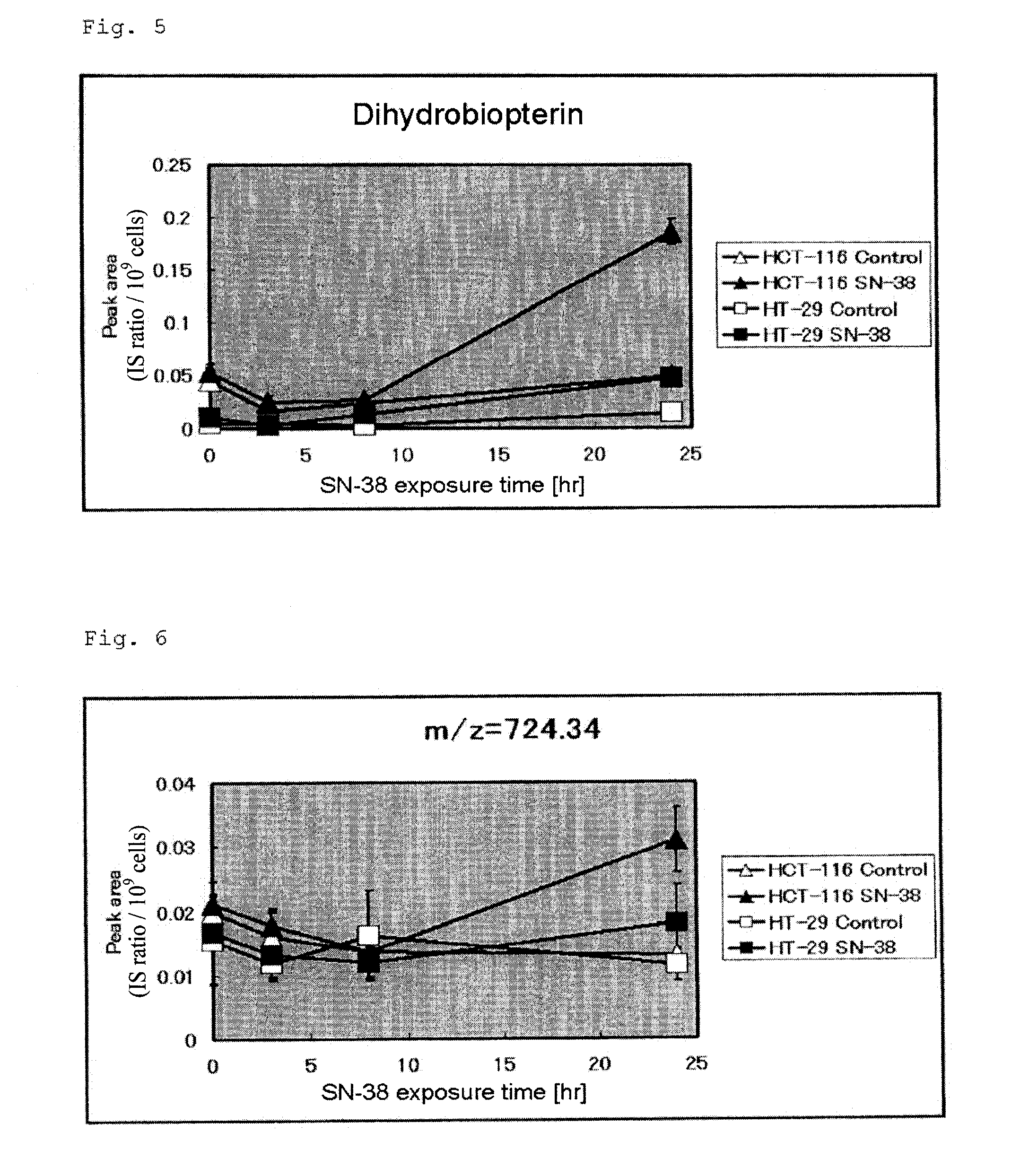Anticancer agent sensitivity-determining marker
a technology of anticancer agents and markers, applied in the field of markers, can solve the problems of low response rate of such chemotherapy, interindividual differences, and ineffectiveness of anticancer agents for some cancers, and achieve the effects of enhancing expected cancer therapeutic effect, and promoting anticancer agent sensitivity
- Summary
- Abstract
- Description
- Claims
- Application Information
AI Technical Summary
Benefits of technology
Problems solved by technology
Method used
Image
Examples
example 1
[0086](1) Method[0087](a) Cells Employed
[0088]Two human colorectal cancer cell lines (HCT-116 and HT-29) employed were obtained from Kabushiki Kaisha Yakult Honsha.
[0089]Cell culturing was performed by means of a φ100 mm / Tissue Culture Dish (IWAKI) with a medium (Doulbecco's modified Eagle's Medium, 10% fetal bovine serum) at 37° C. under 5% CO2.[0090](b) Drugs
[0091]SN-38 powder was obtained from Kabushiki Kaisha Yakult Honsha. SN-38 was dissolved in DMSO, and, before use, the solution was diluted so that the DMSO concentration of each of the culture media employed in experiments was adjusted to 0.1% or less.[0092](c) Evaluation of Sensitivity of Cancer to SN-38
[0093]Cells of two colorectal cancer cell lines (HCT-116 and HT-29) were exposed to 50 nmol / L SN-38, and 24, 48, and 72 hours after drug exposure, cell viability was determined by means of an MTS assay (CellTiter96™AQueous One Solution Cell Proliferation Assay, Promega). Sensitivity evaluation of each cell line was performed ...
example 2
[0126](1) Method[0127](a) Cells Employed
[0128]Eight human colorectal cancer cell lines (HCT-116, HT-29, HCT-15, Lovo, LS174T, SW480, SW620, and WiDr) were employed. HCT-116 and HT-29 were obtained from Kabushiki Kaisha Yakult Honsha. Lovo, SW480, and WiDr were obtained from Dainippon Sumitomo Pharma Co., Ltd. HCT-15 and LS174T were obtained from Cell Resource Center for Biomedical Research, Institute of Development, Aging and Cancer, Tohoku University. SW620 was obtained from Summit Pharmaceuticals International Corporation.[0129](b) Drugs
[0130]SN-38 powder was obtained from Kabushiki Kaisha Yakult Honsha. SN-38 was dissolved in DMSO, and, before use, the solution was diluted so that the DMSO concentration of each of the culture media employed in experiments was adjusted to 0.1% or less.[0131](c) Evaluation of Sensitivity of Cancer to SN-38
[0132]Cancer cells of each cell line were exposed to SN-38 (0 nmol / L to 5 μmol / L) for 72 hours. After exposure to SN-38, cell viability was deter...
example 3
[0146](1) Method
[0147]The experiment procedure of Example 2 was repeated twice. The data obtained in the experiments (three times in total) were further analyzed. Peaks detected through CE-TOFMS in the tested cell samples were compared with the data of 278 standard samples whose m / z values and migration times were already known, whereby 146 metabolites were identified in any of the tested cell samples. The 146 metabolites were investigated through single regression analysis in terms of the correlation between the intracellular content (in eight human colorectal cancer cell lines) and Log[IC50] of each cell line.
[0148](2) Results[0149](a) Evaluation of Sensitivities of Eight Human Colorectal Cancer Cell Lines to SN-38
[0150]The sensitivity of each of eight human colorectal cancer cell lines (HCT-116, HT-29, HCT-15, Lovo, LS174T, SW480, SW620, and WiDr) was evaluated by employing IC50 calculated through MTS assay as an index. As a result, WiDr exhibited the highest IC50 (63.27±10.95 nM...
PUM
| Property | Measurement | Unit |
|---|---|---|
| Ratio | aaaaa | aaaaa |
| Sensitivity | aaaaa | aaaaa |
Abstract
Description
Claims
Application Information
 Login to View More
Login to View More - R&D
- Intellectual Property
- Life Sciences
- Materials
- Tech Scout
- Unparalleled Data Quality
- Higher Quality Content
- 60% Fewer Hallucinations
Browse by: Latest US Patents, China's latest patents, Technical Efficacy Thesaurus, Application Domain, Technology Topic, Popular Technical Reports.
© 2025 PatSnap. All rights reserved.Legal|Privacy policy|Modern Slavery Act Transparency Statement|Sitemap|About US| Contact US: help@patsnap.com



